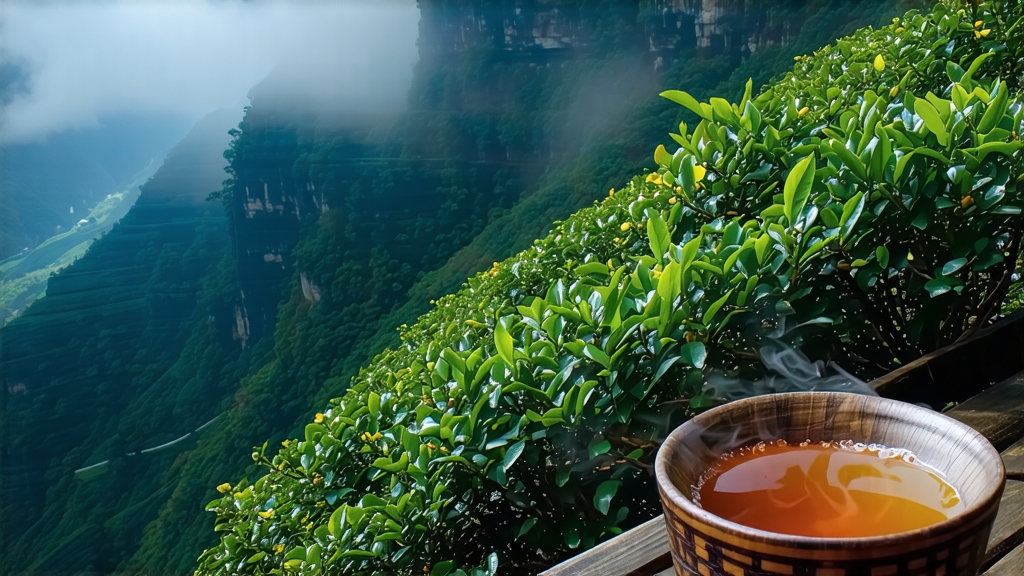
If green tea is the fresh-faced youth of Chinese tea and pu-erh the wise elder, then Da Hong Pao sits between them like a charismatic middle-aged monarch—mature yet vigorous, wrapped in legend, and crowned with the mineral majesty of the Wuyi Mountains. Internationally known as “Big Red Robe,” this rock oolong (yancha) carries within its twisted, charcoal-kissed leaves the taste of cliffs, pine smoke, and centuries of courtship between human craftsmanship and rugged terroir.
-
Myth and documented history
The romantic origin most repeated in Fujian villages tells of a Ming-dynasty scholar who, on his way to the capital for imperial exams, fell ill outside the Wuyi monastery. Monks brewed leaves picked from nearby bushes; the traveler revived, passed the exams, and returned in crimson robes to drape the bushes in gratitude—hence “Big Red Robe.” While the tale is unverifiable, written records from the early 1600s already list “Yancha” tributes sent to the imperial court, and Qing-era tax scrolls note specific levies on “Robe Tea.” By the late 19th century, Wuyi tea makers were exporting roasted oolongs through the port of Xiamen to Southeast Asia and Europe, where Dutch traders auctioned it as “Thee van de Rode Rok.” The 1980s saw a renaissance: state researchers propagated cuttings from the original mother bushes (still visible but no longer harvested on Jiulongke cliff), giving birth to the garden-grown “commercial” Da Hong Pao that now satisfies global demand while protecting the ancient plants. -
Terroir: why rocks rhyme
UNESCO designated the Wuyi range a World Heritage site for its Danxia landforms—steep, iron-rich cliffs that absorb daytime heat and radiate it at night, creating a 10-15 °C diurnal swing. Rainwater trickles through fractured shale, picking up minerals that feed the tea roots. Locals speak of “rock rhyme” (yan yun), a tactile finish reminiscent of wet stone, lichen, and orchid that lingers in the throat long after swallowing. Only leaf picked within the 60 km² core scenic zone may be labeled Zheng Yan (True Cliff); outside gardens produce Ban Yan (Half Cliff) or Zhou Cha (River Valley) styles with softer body and less lingering minerality. -
Cultivars under the Red Robe umbrella
The original six mother bushes belong to three distinct cultivars—Qi Dan, Bei Dou, and Que She—each now micro-propagated. Gardeners also blend selected Wuyi bushes such as Tie Luo Han, Bai Ji Guan, and Shui Jin Gui to create “commodity” Da Hong Pao that balances fragrance, body, and price. A further category, “Old Bush,” denotes tea plucked from shrubs over thirty years old whose deep roots channel more minerals and whose thicker leaves withstand heavier roasting. -
Crafting the cliff king
Harvest takes place in late April when two leaves and a bud reach the “small open face” stage—edges curling upward like tiny boats. The pluck is transported down narrow mountain paths in bamboo baskets lined with linen to prevent bruising. Once in the village workshop, the leaves wither under natural sunlight for 30–45 minutes, then indoors on water-weed mats while artisans shake, tumble, and toss them in bamboo drums to edge-oxidize. When the green aroma turns to peach and jasmine, the leaf is fixed in 240 °C woks for five minutes, rolled into the signature strip-twist shape, and given an initial bake at 100 °C. The decisive step is charcoal roasting: pinewood embers are buried in ash to hold 80–120 °C for 6–16 hours, repeated two to four times over three months. Between roasts the tea “rests,” allowing moisture to migrate outward so each successive fire drives the roast deeper without scorching. Master roasters judge heat by hand, pressing the leaf piles to feel internal temperature—an art passed father to son, mother to daughter. -
Grading and authenticity
True Cliff Da Hong Pao yields barely 500 kg a year, sold at pre-auction to invited buyers; most drinkers encounter blended versions. Quality markers are: (a) dry leaf that is matte charcoal rather than glossy black, (b) a brew that glows amber under light, not